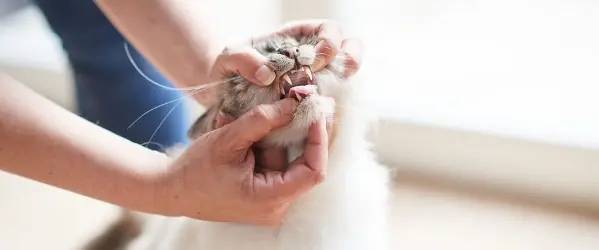Signs of dental problems in cats and dogs
Dental disease is a serious and painful issue for our pets, not just impacting their oral health but their overall health as well. If poor dental hygiene is left to develop it can have severe consequences, for both you and your pet, including the need for invasive and expensive veterinary treatment.
Some pet dental problems, such as gingivitis and plaque, can easily be treated and prevented by you at home if caught early enough. But others, such as tartar build-up or periodontal disease, will require veterinary treatment, which could be expensive for you and stressful for your pet. Severe cases of periodontal disease in cats and dogs leads to the loss of teeth and jaw, and can put a strain on their heart, kidneys and other internal organs.
How to prevent periodontal disease and other dental problems in cats and dogs
Healthy cat and dog teeth should be white and shiny, with pink gums and no bad breathThe best way to keep your cat or dog’s teeth healthy and prevent dental problems occurring is to provide regular dental care. This includes checking their teeth for signs of dental disease, and knowing the signs of dental problems to look out for. Most vets will check your pet’s teeth during their annual check-up, but owners should also brush their pet’s teeth and check their mouth for signs of dental problems several times a week.
When giving your pet a dental check-up, pay attention to their teeth, gums and breath. Healthy teeth are shiny and white/cream in colour, with no rough patches. Your pet’s gums will be pink with no sign of redness, and no bad breath.
However, if you notice any of the following signs or symptoms, your pet could be suffering from a dental problem.
Clinical signs of dental problems
- Halitosis (bad breath) – dogs in particular have a reputation for ‘smelly breath’ but this is often the first sign a dental problem could be occurring. If you notice your cat or dog has bad breath, take extra care to check for signs of any other dental problems. It could just be something they’ve eaten, but if you notice it getting worse or persisting, even with regular dental care, you may wish to get a second opinion from your vet.
- Calculus (tartar build-up) – yellow or brown in colour, tartar forms in layers on the tooth. Tartar cannot be removed by brushing at home; you will need to seek veterinary advice.
- Red, swollen and/or bleeding gums – this is usually a sign your pet is suffering from gingivitis. If left untreated, this can lead to periodontal disease and tooth loss, but if caught early it is easily reversible. Continue brushing your pet’s teeth as normal, but if the bleeding gets worse or doesn’t improve contact your vet.
- Loose teeth – if your pet has loose teeth, it suggests there is an infection that is pushing the tooth out of its socket, and you should seek veterinary advice immediately.
- Dribbling or saliva stains around the mouth or front legs – oral pain and infection can cause an increased production of saliva, leading to dribbling or fur staining.
Can you spot dental problems without giving your pet a dental check-up?
Our pets, cats in particular, often hide signs of pain or discomfort. This means our pets can successfully hide dental problems from us until it has reached an irreversible stage. If you’re not giving regularly cleaning or checking your pet’s teeth, then the first sign your pet is suffering with dental problems could be a change in behaviour.
Behavioural signs of dental problems
- Grooming less
- Pawing at their mouth
- Dropping food or eating less
- Reluctance to go outside or play
- Change in behaviour or aggression when being handled, particularly around the mouth
Some of the these behavioural signs of dental problems can also signify another issue, so you may wish to contact your vet to investigate further.
How do I keep your cat or dog’s teeth clean and healthy?
The easiest way to keep your pet’s teeth clean and prevent dental problems is to introduce them to a dental care routine. You can introduce dental care to your cat or dog at any age, but it may take longer with adult pets.
The gold standard of pet dental care is to brush your cat or dog’s teeth once a day, using a toothpaste specifically designed for cats and dogs. Human toothpastes often contain fluoride and foaming agents that can make pets ill.
Our step-by-step guide to brushing your pet’s teeth explains how you can introduce this to your pet. Ideally, you should brush your pet’s teeth daily, but a thorough cleaning 2–3 times a week will give a marked improvement.
While tooth brushing is great for your pet’s oral health and an enjoyable experience for many pets, for some (particularly cats) it can prove too difficult. That is Beaphar has a range of no-brush dental care products also available. From gels to sprays to treats, there is a product for even the fussiest of pets.
Component ProductGrid:
Message: Enter at least 4 SKU'S and at most 9 SKU'S, to display the grid.
This is the amount of unique existing products that we found:


